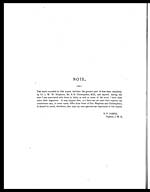Medicine - Institutions > Army health reports and medical documents > Scientific memoirs by officers of the Medical and Sanitary Departments of the Government of India > Number 2 - Malaria in India > Part I > Methods of investigation
(9) [Page 1]
Download files
Individual page:
Thumbnail gallery: Grid view | List view
![(1) [Page 1] -](https://deriv.nls.uk/dcn17/7502/75022375.17.jpg)
MALARIA IN INDIA.
PART I.
METHODS OF INVESTIGATION.
I PROPOSE first to describe, under the following headings, some methods we
have employed in our investigations :—
(1) Methods for the examination of the blood.
(2) Methods for the examination of the malaria parasite in mosquitoes.
(3) Methods for the investigation of malaria in hospitals and jails.
(4) Methods for the investigation of malaria among the general popula-
tion.
(5) Methods for the study of mosquitoes.
I.—The examination of the blood.
The diagnostic evidence of malarial infection which can be obtained from a
microscopic examination of the blood is as follows:—
(a) The detection of malaria parasites.
(b) The detection of malarial pigment in the leucocytes.
(c) The detection of a change in the proportion of the large mono-
nuclear leucocytes.
The two last are valuable when from any cause—such as the previous ad-
ministration of quinine—parasites cannot be found in the peripheral circulation.
For the detection of parasites, the blood may be examined in fresh prepara-
tions, or in dried and stained films.
When the object is to study carefully any individual case of malaria in a
hospital, it is necessary to examine both fresh and stained preparations of blood
taken at the same time.
As a rule, however,—and especially in cases where only one specimen of
blood can be obtained,—far more information is gained by the examination of
stained films than from wet preparations, and for routine work we have usually
employed this method.
In taking blood films for staining purposes the film of blood should be
spread on a glass slide with the surgical needle with which the finger has been
pricked. This method offers great advantages over any other, for not only
B
Set display mode to: Large image | Zoom image | Transcription
Images and transcriptions on this page, including medium image downloads, may be used under the Creative Commons Attribution 4.0 International Licence unless otherwise stated. ![]()
| Permanent URL | https://digital.nls.uk/75022373 |
|---|
| Shelfmark | IP/QB.10 |
|---|---|
| Additional NLS resources: | |




